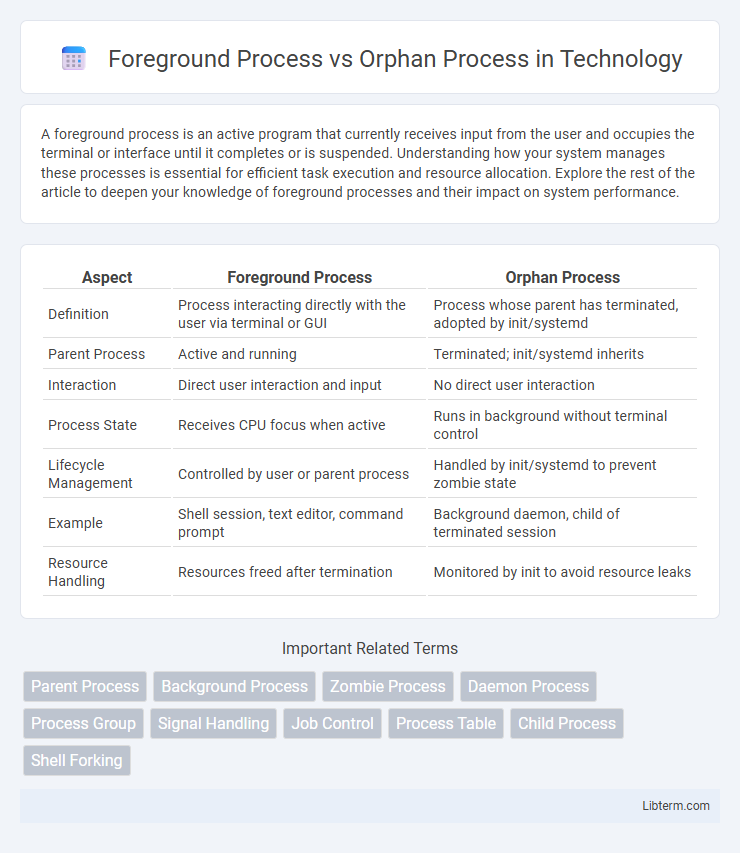A foreground process is an active program that currently receives input from the user and occupies the terminal or interface until it completes or is suspended. Understanding how your system manages these processes is essential for efficient task execution and resource allocation. Explore the rest of the article to deepen your knowledge of foreground processes and their impact on system performance.
Table of Comparison
| Aspect | Foreground Process | Orphan Process |
|---|---|---|
| Definition | Process interacting directly with the user via terminal or GUI | Process whose parent has terminated, adopted by init/systemd |
| Parent Process | Active and running | Terminated; init/systemd inherits |
| Interaction | Direct user interaction and input | No direct user interaction |
| Process State | Receives CPU focus when active | Runs in background without terminal control |
| Lifecycle Management | Controlled by user or parent process | Handled by init/systemd to prevent zombie state |
| Example | Shell session, text editor, command prompt | Background daemon, child of terminated session |
| Resource Handling | Resources freed after termination | Monitored by init to avoid resource leaks |
Introduction to Foreground and Orphan Processes
Foreground processes are active programs initiated by users that require direct interaction and control over system resources, often running within a shell or terminal session. Orphan processes occur when their parent processes terminate before they do, causing the system's init process (PID 1) to adopt them to ensure proper management and resource cleanup. Understanding the lifecycle and management of these processes is crucial for optimizing system performance and stability.
Definition of Foreground Process
A foreground process is an active program in an operating system that interacts directly with the user, receiving input from the keyboard and displaying output on the screen. It runs in the main execution thread and halts other processes until it completes or is interrupted. In contrast, an orphan process continues running after its parent process has terminated, often adopted by the init system to ensure proper resource management.
Definition of Orphan Process
An orphan process is a child process whose parent process has terminated before it, causing the orphan to be adopted by the init system (PID 1) to ensure proper resource management. This differs from a foreground process, which is actively interacting with the user and receives input directly from the terminal. Orphan processes are automatically reparented, preventing them from becoming zombie processes and enabling the operating system to maintain process hierarchy and stability.
How Foreground Processes Work in Operating Systems
Foreground processes in operating systems are actively controlled and interact directly with the user through the terminal or graphical interface. These processes receive input from the user and produce output, maintaining control of the CPU until completion or until they yield control. They contrast with orphan processes, which continue running in the background without direct user interaction, often orphaned when their parent process terminates.
How Orphan Processes Are Created
Orphan processes are created when a foreground or background process terminates before its child process, leaving the child process without a parent. The init system (PID 1) automatically adopts these orphan processes to ensure system stability and resource management. This adoption prevents zombies and allows orphan processes to continue execution until completion or termination.
Key Differences: Foreground Process vs Orphan Process
Foreground processes actively interact with users and have control of the terminal, executing tasks with direct input/output communication. Orphan processes continue running after their parent process terminates and are adopted by the init system (PID 1) to ensure system stability. Key differences include user interaction presence, terminal control, and process parentage management within the operating system.
Process Management and Control Mechanisms
Foreground processes actively interact with users and receive input directly from the terminal, while orphan processes continue running after their parent has terminated and are adopted by the init system for management. Process management mechanisms ensure foreground processes have immediate access to system resources and control signals, whereas orphan processes rely on init for cleanup and resource deallocation. Control mechanisms like signal handling and process group management differentiate how these processes respond to termination requests and scheduling priorities.
Use Cases and Examples of Foreground Processes
Foreground processes actively interact with users and are common in applications like word processors, web browsers, and media players, where real-time user input and immediate output feedback are essential. These processes run in the terminal or GUI with direct access to input devices such as keyboards and mice, enabling tasks like document editing or video playback. In contrast, orphan processes occur when a parent process terminates before its child, requiring the init system or another process to adopt the orphan to maintain system stability.
Consequences and Handling of Orphan Processes
Foreground processes interact directly with the user and demand immediate system resources, while orphan processes occur when their parent process terminates prematurely, causing these child processes to be adopted by the init system (PID 1). Orphan processes can lead to resource leaks and system inefficiencies if not properly managed, as they continue to consume CPU and memory without supervision. Handling orphan processes involves the init system automatically reaping these processes to prevent accumulation, employing signals such as SIGCHLD to clean up and release system resources effectively.
Conclusion: Choosing the Right Process Type
Foreground processes demand active user interaction and immediate resource allocation, making them ideal for tasks requiring real-time input. Orphan processes, which continue running independently after the parent terminates, ensure critical background tasks complete without interruption. Selecting the appropriate process type depends on the need for user engagement versus uninterrupted background execution, optimizing system performance and resource management accordingly.
Foreground Process Infographic

 libterm.com
libterm.com